
There has been a tenfold increase in acute liver fluke cases in sheep in the last quarter of 2012 compared to the same period in 2011, according to AHVLA figures reported in the latest NADIS (National Animal Disease Information Service) Parasite Forecast.
It says that the very wet conditions last summer will have resulted in heavy pasture contamination, with significant risk to stock continuing into February.
Even though a prolonged deep freeze should help to reduce risk to livestock posed by contaminated pastures, the forecast, sponsored by Merial Animal Health, warns: "Many cattle will have been exposed to high levels of liver fluke challenge when at grass. Chronic fluke disease leading to weight loss, poor growth and poor production can be found at any time of year, but there is a peak of cases over the winter."
"Faecal egg identification, blood tests and bulk milk tests in dairy cows can be used to monitor herds for levels of infection but it’s worth looking out for signs of disease and anaemia, bottle jaw, poor fertility and poor milk yield or metabolic disease in dairy cows."
Fiona MacGillivray, Merial Animal Health’s Veterinary Adviser, says: "Any winter treatments in housed or outwintered cattle will depend on previous treatments as well as likely risk, and should be discussed with your vet or animal medicines prescriber."
"Grazing cattle may have been exposed to fresh infection after any previous treatments, and housed cattle which have not been treated since removal from pasture are likely to be showing signs of chronic fluke disease."
"They should be treated now to remove the fluke but bear in mind that affected animals will take some time to show a recovery to better body condition."
Calves and yearlings may also have been exposed to high levels of worm infection when grazing in the autumn, warns MacGillivray.
She said: "In autumn most of the infection becomes inhibited in the stomach wall of the cattle, and doesn’t cause immediate disease. But problems may occur in January and February when the dormant larvae begin to develop again."
"If large numbers emerge from the gut wall at the same time, Type 2 ostertagiosis can result with watery scour and dehydration."
NADIS says that usually only a small proportion of the group is affected, but those animals are often severely ill and some may die. Very occasionally, adults may be affected.
Group 3 (ivermectin-type) wormers are usually recommended for youngstock at housing to prevent Type 2 ostertagiosis, as they are effective against the inhibited larval stages.
Local farm conditions may vary so consult your veterinary surgeon or animal medicines prescriber. Parasite control should be part of your veterinary health plan.
